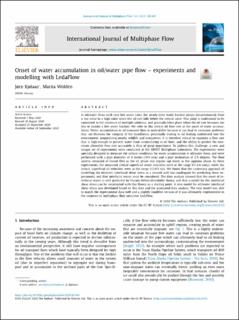| dc.contributor.author | Kjølaas, Jørn | |
| dc.contributor.author | Wolden, Marita | |
| dc.date.accessioned | 2020-11-17T10:58:07Z | |
| dc.date.available | 2020-11-17T10:58:07Z | |
| dc.date.created | 2020-11-11T13:54:31Z | |
| dc.date.issued | 2020 | |
| dc.identifier.issn | 0301-9322 | |
| dc.identifier.uri | https://hdl.handle.net/11250/2688223 | |
| dc.description.abstract | In oil/water flows with very low water rates, the steady-state water fraction jumps discontinuously from a low value to a high value when the oil rate falls below the critical value. This jump is understood to be connected to the existence of multiple solutions, and generally takes place when the oil rate becomes too low to sustain a low water fraction. We refer to this critical oil flow rate as the onset of water accumulation. Water accumulation in oil transport lines is undesirable because it can lead to corrosion problems that can threaten the integrity of the installation, potentially leading to oil leaking undetected into the environment, jeopardizing nearby wildlife and ecosystems. It is therefore critical to maintain a flow rate that is high enough to prevent water from accumulating in oil lines, and the ability to predict the minimum allowable flow rate accurately is thus of great importance. To address this challenge, a new and unique set of experiments were conducted at the SINTEF Multiphase Laboratory. The experiments were specially designed to measure the critical conditions for water accumulation in oil/water flows and were performed with a pipe diameter of 8 inches (194 mm) and a pipe inclination of 2.5 degrees. The fluid system consisted of Exxsol D60 as the oil phase and regular tap water as the aqueous phase. In these experiments, the measured critical superficial water velocities were in the range 0.1-2.6 mm/s, while the critical superficial oil velocities were in the range 0.3-0.5 m/s. We found that the customary approach of modelling the oil/water interfacial shear stress as a smooth wall was inadequate for predicting these experiments, and that interfacial waves must be considered. The data analysis showed that the onset of interfacial waves is well predicted by Viscous Kelvin-Helmholtz theory, and that a model for the interfacial shear stress can be constructed with this theory as a starting point. A new model for oil/water interfacial shear stress was developed based on this data and the associated data analysis. The new model was able to match the experimental data well and a slightly modified version of it was ultimately implemented in the commercial multiphase flow simulator LedaFlow. | en_US |
| dc.language.iso | eng | en_US |
| dc.publisher | Elsevier | en_US |
| dc.rights | Navngivelse 4.0 Internasjonal | * |
| dc.rights.uri | http://creativecommons.org/licenses/by/4.0/deed.no | * |
| dc.subject | Flerfasestrømning | en_US |
| dc.subject | Multiphase flow | en_US |
| dc.title | Onset of water accumulation in oil/water pipe flow – experiments and modelling with LedaFlow | en_US |
| dc.type | Peer reviewed | en_US |
| dc.type | Journal article | en_US |
| dc.description.version | publishedVersion | en_US |
| dc.rights.holder | Copyright: 2020 The Authors | en_US |
| dc.subject.nsi | VDP::Petroleumsteknologi: 512 | en_US |
| dc.subject.nsi | VDP::Petroleum engineering: 512 | en_US |
| dc.source.pagenumber | 11 | en_US |
| dc.source.volume | 134 | en_US |
| dc.source.journal | International Journal of Multiphase Flow | en_US |
| dc.identifier.doi | 10.1016/j.ijmultiphaseflow.2020.103469 | |
| dc.identifier.cristin | 1846975 | |
| dc.relation.project | Norges forskningsråd: 281881 | en_US |
| dc.source.articlenumber | 103469 | en_US |
| cristin.ispublished | true | |
| cristin.fulltext | original | |
| cristin.qualitycode | 1 | |

